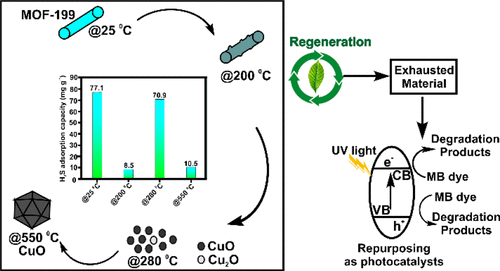Our official English website, www.x-mol.net, welcomes your feedback! (Note: you will need to create a separate account there.)
From MOF-199 Microrods to CuO Nanoparticles for Room-Temperature Desulfurization: Regeneration and Repurposing Spent Adsorbents as Sustainable Approaches
ACS Omega ( IF 4.1 ) Pub Date : 2021-09-22 , DOI: 10.1021/acsomega.1c03712 Nishesh Kumar Gupta 1, 2 , Jiyeol Bae 1, 2 , Kwang Soo Kim 1, 2
ACS Omega ( IF 4.1 ) Pub Date : 2021-09-22 , DOI: 10.1021/acsomega.1c03712 Nishesh Kumar Gupta 1, 2 , Jiyeol Bae 1, 2 , Kwang Soo Kim 1, 2
Affiliation

|
MOF-199 is one of the well-studied metal–organic frameworks (MOFs) for the capture of small gas molecules. In this study, we have investigated the thermal transformation of MOF-199 microrods to CuO nanoparticles by various microscopic and spectroscopic techniques. The growth of oxide was initiated by the formation of ∼2.5 nm particles at 200 °C, which ended up as CuO nanoparticles of ∼100–250 nm size at 550 °C. An intermediate presence of Cu2O along with CuO was recorded at 280 °C. The MOF and calcined products were tested for the room-temperature desulfurization process. MOF-199 showed the maximum adsorption capacity for H2S gas (77.1 mg g–1) among all adsorbents studied. Also, MOF-199 showed a better regeneration efficiency than the derived oxide. For a sustainable process, the exhausted adsorbents were used for the photocatalytic degradation of methylene blue. The exhausted materials showed better degradation efficiencies than the fresh materials. This study reports new sustainable approaches for MOF-199 application in air and water decontamination.
中文翻译:

从 MOF-199 微棒到用于室温脱硫的 CuO 纳米颗粒:再生和重新利用废吸附剂作为可持续方法
MOF-199 是一种经过充分研究的用于捕获小气体分子的金属有机骨架 (MOF)。在这项研究中,我们通过各种显微和光谱技术研究了 MOF-199 微棒向 CuO 纳米颗粒的热转变。氧化物的生长是通过在 200°C 下形成~2.5 nm 颗粒而开始的,最终在 550°C 下形成~100-250 nm 尺寸的 CuO 纳米颗粒。在 280 °C 时记录了 Cu 2 O 和 CuO的中间存在。MOF 和煅烧产品进行了室温脱硫过程的测试。MOF-199 显示出对 H 2 S 气体的最大吸附容量(77.1 mg g –1) 在所有研究的吸附剂中。此外,MOF-199 显示出比衍生氧化物更好的再生效率。对于可持续的过程,用尽的吸附剂用于光催化降解亚甲蓝。用尽的材料比新鲜材料表现出更好的降解效率。该研究报告了 MOF-199 在空气和水净化中应用的新可持续方法。
更新日期:2021-10-06
中文翻译:

从 MOF-199 微棒到用于室温脱硫的 CuO 纳米颗粒:再生和重新利用废吸附剂作为可持续方法
MOF-199 是一种经过充分研究的用于捕获小气体分子的金属有机骨架 (MOF)。在这项研究中,我们通过各种显微和光谱技术研究了 MOF-199 微棒向 CuO 纳米颗粒的热转变。氧化物的生长是通过在 200°C 下形成~2.5 nm 颗粒而开始的,最终在 550°C 下形成~100-250 nm 尺寸的 CuO 纳米颗粒。在 280 °C 时记录了 Cu 2 O 和 CuO的中间存在。MOF 和煅烧产品进行了室温脱硫过程的测试。MOF-199 显示出对 H 2 S 气体的最大吸附容量(77.1 mg g –1) 在所有研究的吸附剂中。此外,MOF-199 显示出比衍生氧化物更好的再生效率。对于可持续的过程,用尽的吸附剂用于光催化降解亚甲蓝。用尽的材料比新鲜材料表现出更好的降解效率。该研究报告了 MOF-199 在空气和水净化中应用的新可持续方法。



























 京公网安备 11010802027423号
京公网安备 11010802027423号